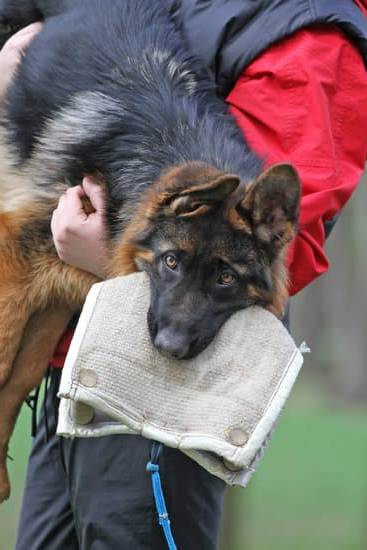Police dogs play a vital role in law enforcement, assisting officers in various tasks such as search and rescue, drug detection, and apprehending suspects. These highly trained animals are considered valuable assets to police forces around the world. But how much does it take to train a police dog? The answer lies in understanding the extensive process involved in preparing these canines for their critical roles in maintaining public safety.
The history of police dog training dates back centuries, with evidence of their use in law enforcement found in ancient civilizations. Over time, specific breeds have been selected and trained to work alongside human officers effectively. The selection process for police dog candidates is rigorous, focusing on qualities such as intelligence, agility, and loyalty. Once chosen, these canines undergo basic obedience training to ensure they can follow commands and interact safely with the community.
Beyond basic obedience, police dogs receive specialized training in areas like detection and tracking. Whether sniffing out drugs or locating missing persons, these skills are honed through rigorous exercises and simulations. However, the journey to becoming a fully-trained police dog comes at a cost.
Expenses related to equipment, food, veterinary care add up over time. Additionally, the commitment of time and resources required from trainers cannot be understated. Ultimately, the investment put into training these loyal companions pays off when success stories illustrate their crucial role in keeping communities safe.
History of Police Dog Training
The history of police dog training dates back to the late 19th century, where dogs were first utilized in law enforcement in Belgium. The idea of using canines to assist police officers quickly gained popularity due to their keen sense of smell, agility, and loyalty. Over time, the concept spread to other countries, including the United States, where police departments began incorporating K9 units into their operations.
Evolution of Police Dog Training
Initially, police dog training focused on basic obedience and tracking skills. However, as law enforcement needs evolved, so did the training methods for police dogs. Today, police dogs undergo rigorous and specialized training to perform a variety of tasks, such as drug detection, explosive detection, search and rescue operations, apprehension of suspects, and even crisis intervention in some cases.
Modern Techniques and Tools
With advances in animal behavior studies and technology, modern police dog training utilizes positive reinforcement techniques to encourage desired behaviors in the dogs. Trainers often use clicker training or food rewards to reinforce correct actions during obedience and specialized tasks.
Additionally, tools such as agility equipment and scent detection kits are used to enhance the skills of police dogs. Overall, the history of police dog training reflects a continual effort to improve methods and produce highly skilled canine partners for law enforcement agencies.
Overall, understanding the history of police dog training provides insight into how these canine companions have become invaluable assets in supporting law enforcement efforts. The dedication and commitment required to train a successful police dog showcase just how much investment goes into preparing these animals for their critical role in keeping communities safe. The evolution of training techniques and tools demonstrates a continuous effort to enhance the capabilities of police dogs for various tasks required in modern law enforcement operations.
Breeds Used in Police Dog Training
When it comes to training police dogs, the selection of the right breed is crucial. Different breeds have specific characteristics that make them more suitable for police work. Some of the most commonly used breeds in police dog training include German Shepherds, Belgian Malinois, Dutch Shepherds, and Labrador Retrievers.
1. German Shepherds: Known for their intelligence, loyalty, and versatility, German Shepherds are one of the most popular choices for police work. They are quick learners and have a strong work ethic, making them well-suited for tasks such as tracking, searching, and apprehending suspects.
2. Belgian Malinois: Similar to German Shepherds in terms of intelligence and trainability, Belgian Malinois are highly energetic and driven dogs. They excel in roles such as detection work, patrol duties, and search and rescue operations.
3. Labrador Retrievers: While not as commonly seen in traditional police roles as German Shepherds or Malinois, Labrador Retrievers are often used in specialized tasks such as detection of explosives or narcotics due to their keen sense of smell and friendly demeanor.
Selecting the right breed for police dog training involves considering factors such as temperament, drive, physical ability, and compatibility with a handler. Each breed brings its own set of strengths to the table which is why it plays a crucial role in determining how much does it take to train a police dog successfully.
By choosing breeds that are well-suited for the specific tasks required in law enforcement work, trainers can set their canine partners up for success in fulfilling their duties effectively on the field.
Selection Process for Police Dog Candidates
The selection process for police dog candidates is a crucial step in ensuring that only the most suitable and capable dogs are chosen for training. This process involves a series of assessments and evaluations to determine if a dog has the necessary traits and characteristics to excel in law enforcement work. Here are some key aspects of the selection process:
- Temperament: One of the most important factors considered during the selection process is the dog’s temperament. Police dogs need to be confident, bold, and highly trainable. They should also possess a strong work drive and be able to remain focused even in high-stress situations.
- Health Evaluation: Prior to being selected for training, potential police dog candidates undergo a thorough health evaluation to ensure they are in optimal physical condition. This includes screenings for any hereditary conditions that may affect their performance as working dogs.
- Drive Assessment: Another important aspect of the selection process is evaluating the dog’s drive, which refers to their desire to work and willingness to engage in tasks such as detection or tracking. Dogs with high hunt or play drives are often preferred for police work.
The process of selecting police dog candidates is not taken lightly, as these dogs will be responsible for assisting law enforcement officers in critical operations. Agencies invest time and resources into carefully evaluating and choosing the most promising candidates based on their temperament, health, and drive. By conducting thorough assessments and evaluations, handlers can ensure that only the best-suited dogs are selected for training.
Ultimately, the success of police dogs in their roles depends significantly on how well they match the requirements set during the selection process. By choosing dogs with the right attributes and characteristics, law enforcement agencies can increase the chances of having highly effective police K9 units that make invaluable contributions to keeping communities safe.
The investment made in selecting top-quality police dog candidates paves the way for successful training outcomes and long-term partnerships between K9 officers and their canine partners.
Basic Training for Police Dogs
Foundation of Basic Training
Training police dogs in obedience and socialization is crucial as it forms the foundation of their performance in law enforcement tasks. Obedience training ensures that the dogs respond promptly to commands from their handlers, which is essential for carrying out tasks effectively. Socialization, on the other hand, helps in acclimating the dog to various environments and people, reducing the likelihood of aggression or fear in unfamiliar situations.
Training Methods
During basic training, police dogs learn essential commands such as sit, stay, heel, and come when called. They also undergo leash training to walk calmly beside their handler without pulling or getting distracted. These exercises are reinforced through positive reinforcement techniques like treats or praise to encourage desired behavior. Consistent training sessions with experienced trainers are essential to ensure that the dogs master these basic skills before moving on to more specialized training.
Duration and Intensity of Training
The duration of basic training for police dogs can vary depending on factors such as breed, age, and prior experience. On average, basic obedience and socialization training can take several weeks to a few months to complete. However, some dogs may require additional time to grasp these fundamental skills fully.
The intensity of training sessions also plays a significant role in how quickly a police dog progresses through basic training. Regular and consistent practice is key to solidifying the dog’s understanding and compliance with commands.
Specialized Training for Police Dogs
Police dogs undergo specialized training in detection and tracking to enhance their abilities in assisting law enforcement agencies. The training is essential in enabling these K-9 units to effectively locate drugs, explosives, weapons, and missing persons. How much does it take to train a police dog for detection and tracking? The process can vary depending on the individual dog’s abilities, the breed, and the specific skills being taught.
The specialized training for police dogs in detection involves teaching them how to use their sense of smell to identify specific odors accurately. Dogs have incredibly sensitive noses capable of detecting even trace amounts of substances.
Training them to recognize these scents and indicate the presence of contraband is a crucial part of their role in law enforcement. Similarly, tracking training focuses on developing the dog’s ability to follow a scent trail left by a person, making them invaluable in search-and-rescue operations.
In addition to the time and effort required by experienced trainers, the cost of specialized training for police dogs can add up quickly. Expenses include equipment such as scent detection kits, tracking harnesses, reward toys or treats, as well as ongoing veterinary care and high-quality food needed to keep these working dogs healthy and motivated.
Despite the investment involved in training police dogs for detection and tracking, the benefits they provide in solving crimes and saving lives make it a worthwhile endeavor for law enforcement agencies.
| Category | Details |
|---|---|
| Training Equipment | Scent detection kits, tracking harnesses |
| Food & Veterinary Care | High-quality food, regular check-ups |
| Other Expenses | Reward toys or treats for motivation |
Costs Associated With Training a Police Dog
Moreover, a significant portion of the budget allocated to training police dogs goes towards providing them with high-quality food to maintain their strength, agility, and overall well-being. A balanced diet is essential for these active and hardworking canines as they undergo rigorous physical training sessions daily.
Additionally, regular veterinary check-ups and medical care are vital in ensuring that police dogs remain in optimal health condition throughout their service life. Vaccinations, preventive treatments for parasites, and emergency medical care are all part of the ongoing expenses associated with caring for these K-9 officers.
In essence, the financial investment required to train a police dog with proper equipment, food supply, and veterinary care can amount to thousands of dollars annually. Despite the costs involved, law enforcement agencies recognize the invaluable contribution that well-trained police dogs make in enhancing public safety and combating crime effectively.
The dedication of resources towards preparing these intelligent and skilled companions reflects a commitment to maintaining law and order within communities while ensuring that these loyal four-legged officers receive the care they need to perform at their best.
| Expenses | Estimated Cost |
|---|---|
| Equipment | $500 – $1,000 |
| Food | $1,200 – $2,000 per year |
| Veterinary Care | $500 – $1,000 per year |
Time and Resources Required for Training a Police Dog
Training a police dog is not a task that can be rushed. It requires a significant amount of time and resources to ensure that the dog is adequately prepared for their duties in law enforcement. The duration of training can vary depending on the specific needs of the police department, as well as the capabilities and temperament of the individual dog. Generally, it can take anywhere from several months to over a year to fully train a police dog.
The training process involves intensive work with professional trainers who specialize in working with police dogs. These trainers use positive reinforcement techniques to teach the dog various commands, behaviors, and skills necessary for their role in law enforcement. This includes obedience training, socialization exercises, scent detection work, tracking techniques, and more. Each step of the training process must be carefully executed to ensure that the dog is fully prepared for their responsibilities on the job.
In addition to time, there are also significant financial costs associated with training a police dog. This includes expenses for equipment such as leashes, harnesses, muzzles, bite suits, agility training tools, and more.
Furthermore, there are ongoing costs for food, veterinary care, grooming supplies, and even potential medical expenses if the dog is injured in the line of duty. Despite these investments of time and money, the value that trained police dogs bring to law enforcement agencies and communities is immeasurable.
Success Stories of Trained Police Dogs in Action
Police dogs play a vital role in law enforcement, utilizing their heightened senses and specialized training to assist officers in various tasks. One notable success story is that of K9 Officer Max, a German Shepherd who works with the K-9 unit in a local police department.
Max has been trained extensively in tracking and detection, making him an invaluable asset in locating missing persons and detecting narcotics. His keen sense of smell has led to numerous successful arrests and the recovery of evidence crucial to solving cases.
Another inspiring tale is that of K9 Officer Luna, a Belgian Malinois who serves alongside her handler in a SWAT team. Luna underwent intense specialized training in apprehension techniques and scent detection, enabling her to quickly respond to high-risk situations. Her swift actions have helped prevent dangerous suspects from escaping and have undoubtedly saved lives within the community. Luna’s dedication and courage are evident each time she fearlessly enters a potentially hazardous environment at her handler’s command.
The question many may have is: how much does it take to train a police dog like Max or Luna? The answer lies in the significant investments of time, resources, and expertise required for their training.
From selecting the right canine candidate to providing proper equipment, food, veterinary care, and ongoing training, the costs associated with developing a skilled police dog are substantial but necessary for ensuring their effectiveness on duty. Nonetheless, the invaluable contributions these well-trained K9 officers make towards maintaining public safety make every penny spent worth it.
Conclusion
Police dogs have proven time and time again to be invaluable assets in law enforcement, showcasing their exceptional skills in various tasks such as detection, tracking, and apprehension. The dedication and hard work that goes into training these canines are truly remarkable.
But the question remains: how much does it take to train a police dog? The answer lies not just in the financial costs involved but also in the time, effort, and resources required to mold these dogs into reliable partners for police officers.
The process of training a police dog is not just about teaching them basic commands or specialized tasks. It involves careful selection of suitable breeds, rigorous training regimens, proper nutrition, veterinary care, and continuous practice to maintain their skills. The costs associated with training a police dog can add up quickly, from purchasing equipment like leashes and harnesses to providing high-quality food and ensuring regular medical check-ups.
Moreover, the time and resources required for training a police dog cannot be underestimated. It takes months of consistent training sessions, dedicated trainers, and an unwavering commitment to developing these dogs’ potential. Despite the challenges and expenses involved in training police dogs, the end results speak for themselves.
These highly-trained canines play a crucial role in keeping communities safe by assisting law enforcement officers in various operations. Their bravery, loyalty, and unmatched abilities make them indispensable allies in the fight against crime.
Frequently Asked Questions
How Long Does It Take to Fully Train a Police Dog?
The time it takes to fully train a police dog varies depending on the specific training program and the individual dog. Typically, it can take anywhere from several weeks to over a year to complete the rigorous training required for police work. The training process involves teaching skills such as obedience, agility, scent detection, and protection work.
Can You Train a Dog Like a Police Dog?
While it is possible to train a dog in a similar manner to that of a police dog, achieving the level of proficiency and reliability required for police work may be challenging for the average pet owner. Training a dog like a police dog requires specialized knowledge, experience, and access to expert guidance.
It’s important to consider whether your goals align with the capabilities of your dog before embarking on this type of training.
Can Any Dog Be a K-9 Police Dog?
Not every dog is suitable for becoming a K-9 police dog. Certain breeds are commonly chosen for police work due to their inherent traits such as German Shepherds, Belgian Malinois, and Dutch Shepherds.
These breeds are often selected for their intelligence, loyalty, agility, strength, and ability to bond closely with their handler. Additionally, individual temperament plays a significant role in determining whether a dog has what it takes to become a successful K-9 police dog.

Welcome to the blog! I am a professional dog trainer and have been working with dogs for many years. In this blog, I will be discussing various topics related to dog training, including tips, tricks, and advice. I hope you find this information helpful and informative. Thanks for reading!





